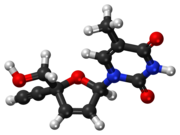Censavudine
 | |
 | |
| Clinical data | |
|---|---|
| Other names | 4'-ethynylstavudine, festinavir |
| Legal status | |
| Legal status |
|
| Identifiers | |
| |
JSmol) | |
| |
| |
Censavudine (INN)
Renaming
Until 2013, censavudine has been known as festinavir, but the name was changed to avoid confusion with HIV protease inhibitors which all bear class suffix "–navir" (e.g. tipranavir, lopinavir, saquinavir etc.).[6]
References
- ^ "International Nonproprietary Names for Pharmaceutical Substances (INN). Proposed International Nonproprietary Names: List 110" (PDF). World Health Organization. pp. 409–410.
- PMID 28559249.
- PMID 26762988.
- ^ Alcorn K (21 December 2010). "Bristol-Myers Squibb buys festinavir, new NRTI active against MDR HIV". aidsmap.com. aidsmap. Retrieved 24 June 2011.
- ^ PubChem. "Censavudine". pubchem.ncbi.nlm.nih.gov. Retrieved 2023-10-24.
- ^ PubChem. "Censavudine". pubchem.ncbi.nlm.nih.gov. Retrieved 2023-10-24.
